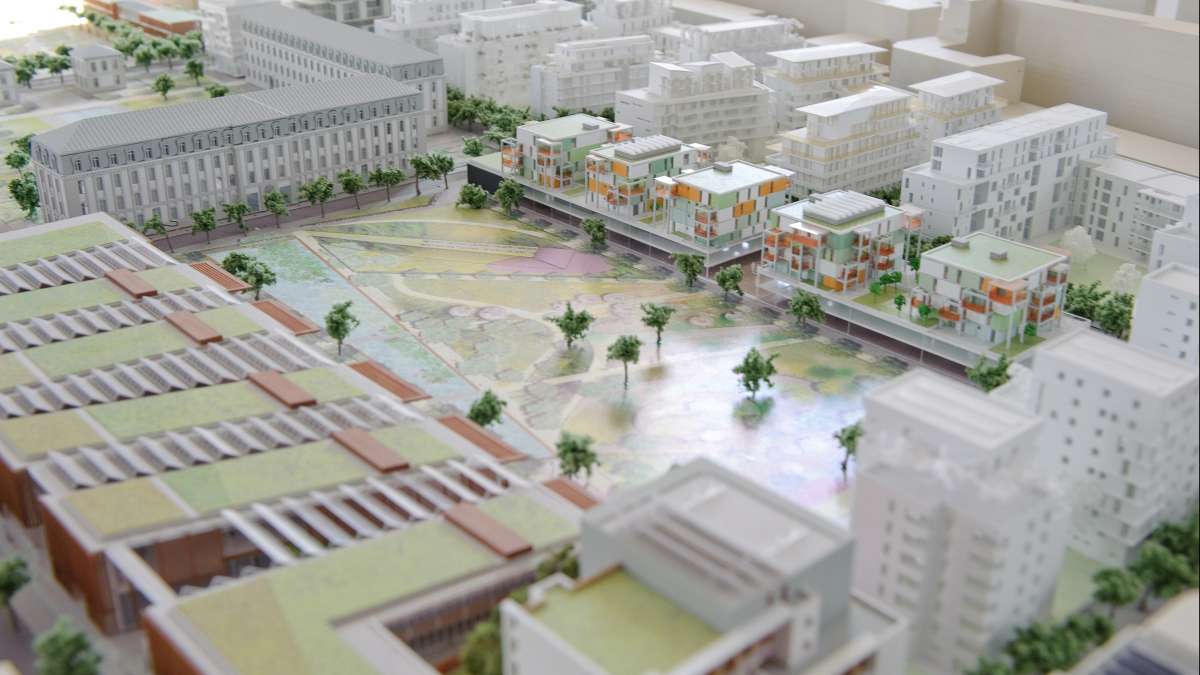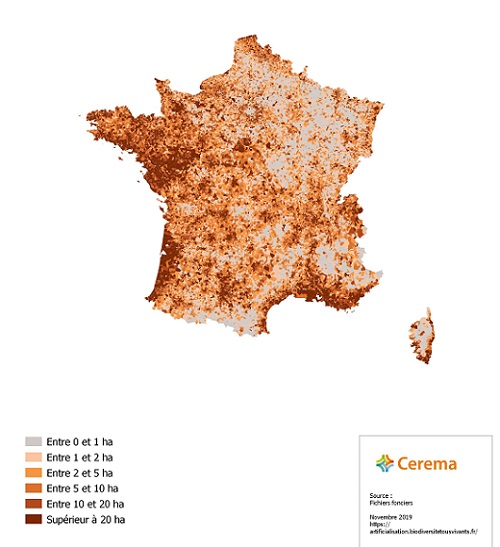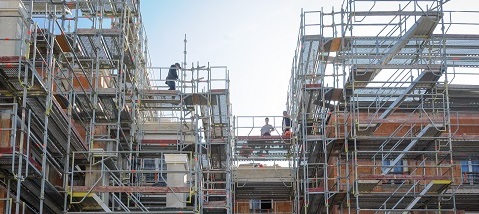
Cerema, which specialises in development, urban planning, prevention and risk management issues, has seized on the issue of Net Zero Artificialisation at the request of the government and to help the regions change their practices.
Evolution of artificialisation in 2018

Cerema provides data from the Soil Artificialisation Observatory on behalf of the ministries in charge of housing, the environment, and agriculture. This observatory provides data on and analyses of the mechanisms of soil artificialisation, along with both quantitative and qualitative data. Each year, approximately 25,000 hectares of natural or agricultural soils are artificialised, mainly for habitat accounting for 70% of the area, followed by activity.
Data for 2018 are available and show a very slight decrease of 0.6% in the rate of soil artificialisation (-139 hectares artificialised in 2018 compared to 2017).
The observatory also now provides data at the square kilometre scale, which will enable more precise regional analyses, including linking artificialisation data to context data (population, income, households, etc.).
A national analysis of these data, which is currently being drafted, will be produced in 2021. In particular, this analysis will characterise the relationship between artificialisation data and construction.
On the form, Cerema should also work to make the data available in an easier way, in particular by improving the map viewer made available.
ZNA (zero net artificialisation), a topic addressed by developers...

Cerema is a member of the National Network of Developers, which brings together the public, parapublic and private operational and urban planning stakeholders. Cycles of meetings on major urban planning and development issues are organised, and Cerema ensures the capitalisation of exchanges.
The Meetings of the National Network of Developers, which took place on 25 September, allowed for exchanges between public and private development stakeholders on the issue of the zero net artificialisation goal and the solutions to meet this objective.
Through round tables and workshops, these meetings aimed to answer the following question: "How can we limit soil artificialisation by supporting French development needs over the entire regional network?".
The summary of exchanges shows that practices are changing: better consideration of soils, development of urban recycling and reuse of wasteland.
Challenges in terms of the acceptability of densification and quality of life, an economic model to make urban production feasible and competitive by regenerating land, are emerging.
It appears necessary to conduct the discussion at the regional level and in a transverse manner, in order to develop a long-term strategy.
... and by medium-sized cities

The Cerema was called upon by ANCT (Agence nationale de la cohésion des territoires) and PUCA (Plan Urbanisme Construction Architecture) as part of the Action Coeur de Ville programme to capitalise on land sobriety feedback and to support demonstrator sites.
The theme of the Solutions Forum, held on 26 November as part of the Action Coeur de Ville programme, was the "Zero Net Soil Artificialisation" objective. This forum aimed to present innovative projects led by communities responding to the call for projects "Pilot Territories in Land Sobriety" to develop urban recycling by questioning the quality and use of land.
Three wasteland rehabilitation projects were presented at the forum (presentations are available on the PUCA website):
-
Re-qualification of the former Auchel bus station (10,574 inhabitants) in Pas-de-Calais as part of an urban renewal project. The project has evolved towards the complete renaturation and de-artificialisation of this site in a highly urbanised area.
-
Conversion of a Tobacco Hall in Dieppe (29,965 inhabitants), Seine-Maritime, into a multiplex cinema. The site, near the station and the city centre, opened at the end of 2019, with a space dedicated to virtual reality and convivial spaces, and had found its audience before the March 2020 lock-down.
-
The collaboration between the Greater Amiens development and town planning agency, which had already drawn up an inventory of wastelands within its region, and Cerema to identify recyclable land deposits using the CartoFriches tool.
The National Action Cœur de Ville programme launched in October the "Pilot land sobriety regions" initiative, to provide engineering support to experiments aimed at reconciling urban development and reduction of artificialisation, to test under real conditions the possibilities and operational limits of approaches to reduce artificialisation, and to capitalise on lessons learned. Cerema is represented in the approach with national pilots to provide its expertise through the analysis of applications and the choice of winners. It also participates in the Steering Committee with pilots, LCA partners and qualified specialists. This body will meet approximately twice a year to review the progress of the process and discuss the desired orientations.
The 7 winning regions of this approach, with very distinct regional issues and contrasting local contexts, have recently been announced:
-
Poitiers / Greater Poitiers Urban community (Nouvelle Aquitaine)
-
Epernay Metropolitan area Champagne / Epernay (Grand Est)
-
Sète / Sète Agglopôle Méditerranée (Occitanie)
-
Dreux / Pays de Dreux Metropolitan area (Centre-Val de Loire)
-
Maubeuge / Maubeuge Metropolitan area -Val de Sambre (Hauts-de-France)
-
Draguignan / Dracénie Provence Verdon metropolitan area (South - Provence Alpes Côte d'Azur)
-
Louviers / Seine-Eure Metropolitan area (Normandy)
All 25 candidates will be part of a Circle of land sobriety Pioneers with the aim of involving them in the dynamics of the experiment.
Cerema present for the implementation of the "Wastelands Fund" of the Recovery Plan

It is estimated that wastelands - industrial, commercial, or other - in France occupy between 90,000 and 150,000 hectares, which constitutes a considerable pool of land that we must be able to reuse.
To achieve the Zero Net Artificialisation (ZNA) objective, an important stake is therefore to promote urban renewal. Communities must identify the available spaces, mainly wastelands, to promote urban renewal and land sobriety.
Thus, as part of the recovery plan, the Government wished to deploy a fund of €300 million to finance wasteland recycling operations. In particular, a budget of €259 million is dedicated to the implementation of regional calls for land recycling projects, to allow the effective implementation of projects to reclaim wastelands.
With its skills and expertise in these subjects, Cerema supports the Ministry of Ecological Transition in the implementation of this action. In particular, it participates in the development of the national framework, and supports the examination of application files via a series of webinars and support for instructors.
Cartofriches and UrbanVitaliz: tools to identify wastelands and support their transformation
The efforts to convert wastelands are proving to be long and complex: the multiplicity of stakeholders, the cost of the cleanup process, the financing difficulties are all obstacles that the Cartofriches and UrbanVitaliz tools which are being developed, aim to overcome.
-
Cartofriches: this platform, currently in beta version, aims to identify and list wastelands throughout the region, with technical information on each site. It is driven by a national database and by local observatories. 2,200 wastelands are already listed there.
-
UrbanVitaliz: developed as part of a state start-up launched in September 2020, whose aim is to produce a digital tool to more specifically support small and medium-sized towns in areas considered to be unstrained in terms of land tenure, in all of their approaches to reconversion of wastelands, deemed to be complex. It will first present the information concerning the identified sites, the stakeholders and tools for the initial site studies, along with the available funding levers.
Cerema alongside communities
Thanks to its regional presence, and its multiple skills linked to the requalification of wastelands and land sobriety, both in terms of operational town planning and the environment or construction, Cerema is also positioned in support of communities.
Support proposals, which can take many forms, will be detailed in 2021. If you have a project or a need, do not hesitate to contact us.
Focus on support:
Cerema is working with the Marseille Urban Planning Agency (AGAM) to develop urban recycling through a study on operations carried out mainly in the Aix-Marseille-Provence metropolitan area, which is affected by strong land pressure.
The reconversion methods for the different sites were analysed, to provide useful feedback for all the regions, by identifying the relevant tools.
Three feedback webinars were organised on 19 and 26 November and 3 December. Following an initial session on the challenges and levers for urban recycling, six workshops enabled discussions on concrete projects as well as on tools and methods: transient town planning, land identification, planning.

